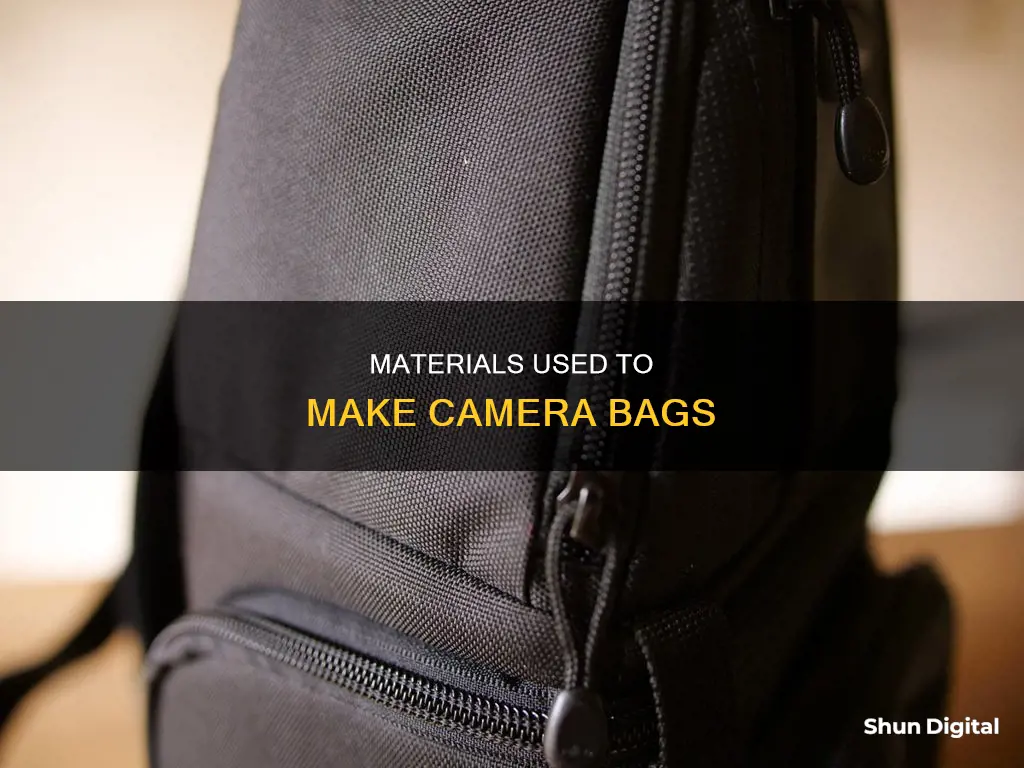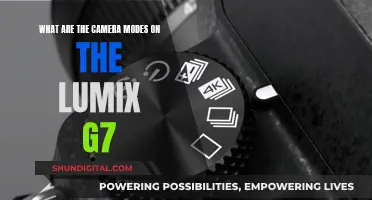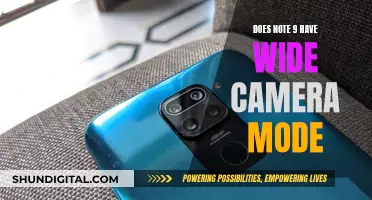
Camera bags have evolved over the years, from the fitted leather cases of the earliest cameras to the wide range of options available today. Camera bags are typically made from durable and water-resistant materials such as leather, canvas, and nylon. Some popular options include shoulder bags, backpacks, sling bags, holster cases, fashion bags, pouches, and rolling cases. Each type of bag offers different features and benefits to cater to photographers' varying needs. When choosing a camera bag, it is important to consider factors such as the type and amount of gear to be carried, comfort, accessibility, and protection from the elements.
| Characteristics | Values |
|---|---|
| Material | Leather, canvas, nylon, polyester, tarpaulin, ballistic nylon, synthetic fabric, Robic nylon, Rip-Stop fabric, YKK zippers, EVA foam, Cordura, cowhide leather, waxed canvas, YKK Fuse zippers |
| Type | Shoulder bags, backpacks, sling bags, roller bags, holster cases, fashion bags, pouches, rolling cases, hard cases, fitted cases, camera straps |
What You'll Learn
- Camera bags can be made of leather, nylon, polyester, canvas, tarpaulin, or synthetic fabric
- Camera bag materials are often waterproof or water-resistant
- Camera bags are designed to be durable and protect equipment from knocks, scrapes, dust, and water damage
- Camera bags are designed to be comfortable to carry for long periods
- Camera bags have internal dividers to keep equipment organised and protected

Camera bags can be made of leather, nylon, polyester, canvas, tarpaulin, or synthetic fabric
Camera bags are designed to carry and protect camera equipment, and they come in various styles, including shoulder bags, backpacks, sling bags, belt packs, and roller bags. The choice of bag depends on factors such as the amount of equipment one needs to carry, mobility requirements, and personal preference.
Camera bags can be made of various materials, including leather, nylon, polyester, canvas, tarpaulin, or synthetic fabric. Here's a more detailed look at each of these options:
Leather Camera Bags
Leather has traditionally been used for camera cases and bags due to its durability and protective qualities. Leather camera bags often exude a sense of elegance and timeless style. However, leather bags can be heavier than those made of synthetic materials, and they may not be as discreet when travelling or working in certain environments.
Nylon Camera Bags
Nylon is a popular choice for camera bags due to its durability, water resistance, and lightweight properties. Many camera bags are made of nylon or a blend of nylon and other synthetic fibres. Nylon camera bags are often reinforced with a high denier count, such as 840-denier or 1680-denier ballistic nylon, making them resistant to wear and tear.
Polyester Camera Bags
Polyester is another common material for camera bags, known for its durability and water-resistant properties. Polyester camera bags are often made with recycled materials, contributing to their eco-friendliness. They can vary in denier count, with some bags featuring 600-denier polyester for long-lasting use.
Canvas Camera Bags
Canvas is a sturdy and durable fabric often chosen for camera bags. It provides a rugged and timeless look while offering protection for camera gear. Canvas camera bags are known for their longevity and ability to withstand the elements. Some canvas bags may be treated with a water-resistant coating to further enhance their protective qualities.
Tarpaulin Camera Bags
Tarpaulin, or tarp, is a waterproof and durable material sometimes used for camera bags. It is often paired with other materials, such as nylon or canvas, to create a robust and weather-resistant bag. Tarpaulin camera bags are ideal for photographers who work in challenging weather conditions or outdoor environments.
Synthetic Fabric Camera Bags
Synthetic fabrics, including various blends of nylon, polyester, and other man-made materials, are commonly used for camera bags. These fabrics offer advantages such as lightweight construction, water resistance, and durability. Synthetic fabric camera bags are often designed to be discreet, blending in with everyday bags while offering specialised protection for camera equipment.
Avoid Congestion Charges: Know Your Camera Blindspots
You may want to see also

Camera bag materials are often waterproof or water-resistant
Camera bags are designed to protect camera equipment and make it easily portable. They come in a variety of materials, sizes, and styles, including backpacks, shoulder bags, sling bags, roller bags, and holsters. The right bag for you will depend on your needs, preferences, and equipment.
When choosing a camera bag, it is important to consider the amount of equipment you have and how much you want to carry with you. If you plan to carry a lot of equipment, a larger bag such as a backpack or roller bag may be more suitable. On the other hand, if you only need to carry a small amount of equipment, a smaller bag such as a sling bag or holster may be a better option. It is also important to think about the size and type of your camera and lenses, as some bags may not accommodate larger cameras or lenses.
Another important consideration is the style of the bag. Do you want a bag that is more active and allows for greater mobility, or a more passive bag that is better for transporting equipment? Backpacks, sling bags, modular systems, and shoulder bags are considered active bags, while roller bags and hard cases are more passive. Some photographers find it useful to have a combination of both, using a passive bag for transportation and an active bag for carrying extra equipment during a shoot.
In addition to size and style, the material of the camera bag is an important consideration. Camera bag materials are often waterproof or water-resistant to protect your equipment from the elements. For example, the Wandrd Rogue sling bag is made of water-resistant 840-denier and 1680D ballistic nylon, while the Peak Design Everyday Backpack Zip is made of 100% recycled 400-denier water-repellent nylon canvas. Waterproof and water-resistant materials are especially important for photographers who work outdoors or in harsh conditions.
Other features to look for in a camera bag include padded and removable inserts, high-quality zippers, tough and wear-resistant exterior fabrics, and lockable zippers for added security. It is also a good idea to choose a bag from a reputable brand that is known for its quality, such as ThinkTank Photo, Manfrotto, or Peak Design.
Charging Your Panasonic Lumix DMC-FZ70 Camera Battery: A Guide
You may want to see also

Camera bags are designed to be durable and protect equipment from knocks, scrapes, dust, and water damage
Camera bags come in a variety of styles, including messenger bags, backpacks, slings, holsters, and roller bags. Each style offers different levels of protection and functionality. For example, messenger bags offer quick access to camera equipment and can be worn across the body, while roller bags provide a convenient way to transport heavy camera gear.
In addition to protection and functionality, camera bags can also provide comfort. Well-designed camera bags distribute weight evenly and have padded straps to reduce strain on the body. Some camera bags also have breathable materials to keep the wearer cool.
When choosing a camera bag, it is important to consider the type of camera and equipment that needs to be carried, as well as the environment in which the bag will be used. For example, a backpack-style camera bag may be more suitable for travelling photographers who need to carry their equipment over long distances, while a holster bag might be a better option for event photographers who need quick access to their camera.
Overall, camera bags are designed with durability and protection in mind, using a range of materials and features to keep camera equipment safe from various types of damage.
High-Res Mode: Maximizing Your Camera's Potential
You may want to see also

Camera bags are designed to be comfortable to carry for long periods
When choosing a camera bag, it is important to consider the amount of equipment you have and how much you want to carry with you. If you plan to carry a lot of equipment, a backpack or roller bag may be a good option, as they can distribute the weight more evenly and be more comfortable for long periods. On the other hand, if you only need to carry a small amount of equipment, a shoulder bag or sling bag might be more suitable.
Another factor to consider is the style of the bag. Some camera bags are designed to look like purses or briefcases, while others have a more traditional camera bag appearance. You may also want to think about the features you need, such as a rain cover, tripod socket, or trolley strap.
In addition, the quality of the bag is important. Look for a bag with padded, removable inserts to protect your equipment and adjustable dividers to customize the space. Also, check the zippers, as they are often the first thing to fail in a camera bag. Choose a bag with tough, wear-resistant exterior fabric that will last.
By considering your equipment needs, preferred style, desired features, and the quality of the bag, you can choose a camera bag that is comfortable to carry for long periods and suits your specific requirements.
Unturned Camera Mode: How to Activate and Use It
You may want to see also

Camera bags have internal dividers to keep equipment organised and protected
Camera bags are designed to keep camera equipment safe and organised. They are often extremely comfortable, more so than a regular rucksack or backpack. They are also designed to be discreet, so as not to draw attention to the user or the equipment inside.
The dividers are usually removable, allowing the user to customise the bag to best suit their equipment. This is particularly useful if the user has a varied kit, or if they plan to buy additional equipment in the future. The ability to remove the dividers also makes the bag more versatile and can be used for storing other items when not in use.
The internal dividers are an important feature of camera bags, ensuring that equipment is organised, protected, and easily accessible.
Charging Up: Camera vs. Car
You may want to see also
Frequently asked questions
Camera bags are typically made of materials such as leather, canvas, nylon, polyester, and tarpaulin. Some bags also have a waterproof coating or are made of waterproof fabric.
Some camera bags are made of waterproof materials or have a waterproof coating, while others come with a rain cover that can be used to protect the bag and its contents from the rain.
High-end camera bags may be made of top-grain leather, ballistic nylon, or other durable and luxurious materials.
Yes, camera bags typically have padding to protect the camera gear inside. The padding may be made of foam, nylon, or other materials.
No, camera bags can also be made of hard materials like plastic. Hard camera cases are often used to protect cameras and equipment during travel or in harsh conditions.







